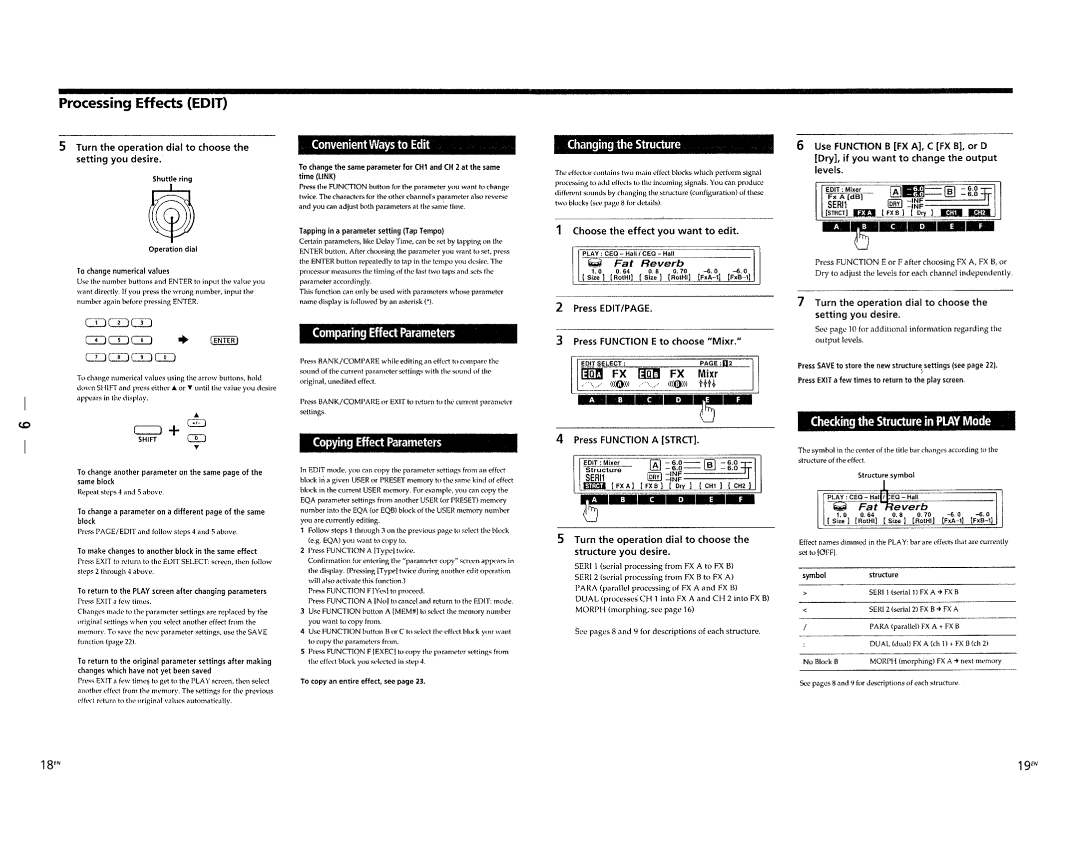
Processing Effects (EDIT)
5 Turn the operation dial to choose the setting you desire.
i
Operation dial
To change numerical values
Use the number buttons and ENTER to input the value you want dire(,tly. If you press the wrong number, input the number again before pressing ENTER.
CDCDo:::J | + [ENTER I |
c::::D CIJ o::J | |
CQ o::J CIJ CIJ |
|
To changl" numerical values using the arrow buttons, hold down SHiFf and press either A or T until the value you desire
app('ar~ in the display.
| A |
(.C | C:=J + C±J |
| |
| SHIFT~ |
| T |
To change another parameter on the same page of the same block
Repeat steps 4 and 5 above.
To change a parameter on a different page of the same block
Press PAGE/EDIT and follow steps 4 and 5 above.
To make changes to another block in the same effect
Press EXIT to return to the EOIT SELECT: "reen, then follow steps 2 through 4 above.
To return to the PLAY screen after changing parameters
Press EXIT a few times.
Chang.,> m,llk to the parameter settings arc replaced by the origin,,1 settings when you select another effect from the
memory. Tt) ~a\"l' the new par,lmetcr settings, use the SAVE
function (p,'ge 22).
To return to the original parameter settings after making changes which have not yet been saved
1',,'" EXIT a f.,\\, tinll'~ to gl't to the I'LA Y screen, tlll'n sell'ct an()ther dfl'ct from the n"'mory. The settings f,)r the pre"ious
dfl'ct return to tlw origin,,} \..llues automatk,llly.
Convenient Ways to Edit
To change the same parameter for CHl and CH 2 at the same time (LINK)
Press the FUNCTION button for the parameter you want to chan)ll' twice. The characters for the other channel's Paraml'ter also reverse and you can adjust both parameters at the sanil' timl'.
Tapping in a parameter setting (Tap Tempo)
Certain paramett'rs, like Delay Time, can be set by tapping on the ENTER button. After choosing the parameter you want to Sl't, press the ENTER button repeatedly to tap in the tempo you desir(>. The
processor measures the timing or the last two t~ps and sets the
parameter accordin)lly.
This function can only be used with parameters whose parameter name display is followl'd by an asterisk (*).
Comparing Effect Parameters
Press BANK/COMPARE while editing an effect to compare the sound of the current parameter settin)ls with the ",und of th(> original, uneditt'<.i effect.
Press BANK/COMPARE or EXIT to rdurn to thl' curr,'nt paramt'lt'r settings.
Copying Effect Parameters
In EDIT mode, you can copy the paraml'l<'r settin~s from an effect block in a )liven USER or PRESET memory to the sanl(' kind of effect block in the current USER ml'mory. For example, you can copy the EQA parameter settings from another USER (or PRESET) memory number into the EQA (or EQB) block of the USER memory numb<.'r you are currently editing.
1Follow steps 1 throu)lh :I on the previous pagt' to sdect the block (e.g. EQA) you want to copy to.
2Press FUNCTION A ITypel twice.
Connrm~tion ror entering the "parameter copy" S(fc('n appears in the display. (Pressing IType! twice durin)l anoth('f edit operation will also activate this function.)
Press FUNCTION F IYes! to proceed.
Press FUNCTION A INo! to cancel and return to the EDIT: mode.
3Use FUNCTION button A IMEM#! 10 select the memory number you want to copy from.
4Use FUNCTION button B or C to "'it"t the dfl"t b"":k you want to copy the parameters rrom.
SPress FUNCTION F IEXEC! to copy the paraml'lt'r settin~s from the effect block you selectt'd in step 4.
To copy an entire effect. see page 23.
Changing the Structure
The
1 Choose the effect you want to edit.
PLAY: CEO - Hall/CEO - Hall
~Fat Reverb
1. 0 | O. 64 | O. 8 | O. 70 |
( Size) (RotHI) [Size) [RotHI)
2Press EDIT/PAGE.
3Press FUNGION E to choose "Mixr."
4Press FUNCTION A [STRG].
5Turn the operation dial to choose the structure you desire.
SERI 1 (serial processing from FX A to FX B) SERI 2 (serial processing from FX B to FX A) PARA (p,H<llleI processing of FX A and FX B)
DUAL (processes Cil 1 into FX A and CH 2 into FX B) MORPH (morphing, see page 16)
See pages 8 and 9 for descriptions of each structure.
6 Use FUNGION B [FX A], C [FX B). or D [Dry], if you want to change the output levels.
Press FUNCTION E or F after choosing FX A, FX B, or Dry to adjust the levels for each channel independently.
7 Turn the operation dial to choose the setting you desire.
See page 10 for additional information regarding the
output levels.
Press SAVE to store the new structur~. settings (see page 22).
Press EXIT a few times to return to the play screen.
Checking the Structure in PLAY Mode
The symbol in the center of the title bar changes according to the structure of the effect.
Structure symbol
Effect names dimmed in the PLA Y: bar are ..ffects that are currently set tu[OFF!.
symbolstructure
SERI I (serial 1) FX A ~ FX B
SERI 2 (serial 2) FX B ~ FX A
PARA (par"lIe!) FX A + FX B
DUAL (dual) FX A (ch 1) + FX B (ch 2)
No Block BMORPH (m(1rphing) FX A ~ next memory
See pages 8 and Y for descriptions of each structure.
18fN | 19fN |
